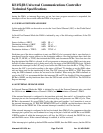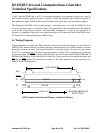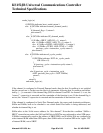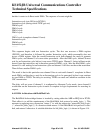
KS152JB Universal Communications Controller
Technical Specifications
Kawasaki LSI USA, Inc. Page 86 of 120 Ver. 0.9 KS152JB2
If the DMA is in alternate cycles mode, then each time DMA cycle is completed DMXRQ goes to
0, thus de-activating
HLD. Once HLD has been de-activate, it can’t be re-asserted till after HLDA
has been to go high (through flip-flop Q1A). Thus every time the DMA is suspended to allow an
instruction cycle to proceed, the requester gives up the bus and must renew the request and receive
another acknowledge before another DMA cycle to XRAM can proceed. Obviously in this case,
the “alternate cycles” mode may consist of single DMA cycles separated by any number of
instruction cycles, depending on how long it takes the requester to regain the bus.
A channel 1 DMA in progress will always be overridden by a DMA request of any kind from
channel 0. If a channel 1 DMA to XRAM is in progress and is over-ridden by a channel 0 DMA
which does not require the bus, DMXRQ will go to 0 during the channel 0 DMA, thus de-activat-
ing
HLD. Again, the requester must re-new its request for the bus, and must receive a new 1-to-0
transition in
HLDA before channel 1 can continue its DMA to XRAM.
4.4 DMA Arbitration
The DMA Arbitration described in this section is not arbitration between two devices wanting to
access a shared RAM, but on-chip arbitration between the two DMA channels on the 8XC152.
The 8XC152 provides two DMA channels, either of which may be called into operation at any
time in response to real time conditions in the application circuit. Since a DMA cycle always uses
the 8XC152’s internal bus, and there’s only one internal bus, only one DMA channel can be ser-
viced during a single DMA cycle. Executing program instructions also requires the internal bus,
so program execution will also be suspended in order for a DMA to take place.
.
Figure above shows the three tasks to which the internal bus of the 8XC152 can be dedicated. In
this figure, Instruction Cycle means the complete execution of a single instruction, whether it
takes 1,2 or 4 machine cycles. DMA Cycle means the transfer of a single data byte from source to
destination, whether it takes 1 or 2 machine cycles. Each time a DMA Cycle or an Instruction
ARBITRA-
TION
LOGIC
DMAO
CYCLE
DMA 1
CYCLE
INSTRUCTION
CYCLE
WRITE
TO
DMA
REG?
YES
NO
0
2


















